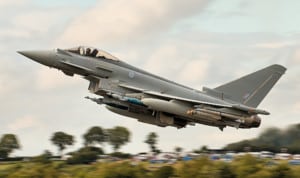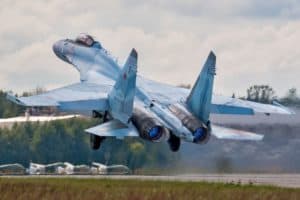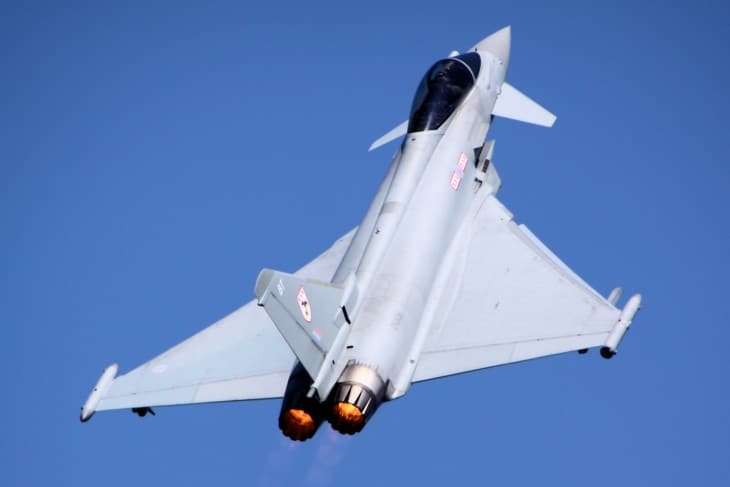There is no doubt that the Eurofighter Typhoon and the Su-35 are both impressive fighter jets. Both have been developed with advanced technology and have been proven to be formidable opponents in the air.
But which one is better? In this article, we will compare the Eurofighter Typhoon vs Su-35 and see which one comes out on top!
| Aircraft: | Eurofighter Typhoon T1 | Sukhoi Su-35 |
|---|---|---|
| Photo: |
 |
 |
| Country: | Germany | Russia |
| Manufactured: | from: 2003 to: Present | from: 1995 to: Present |
| ICAO: | - | SU35 |
| Price: | $90 million | $85 million |
| Avionics: | BAE Systems Tranche 2 avionics | Su-35 cockpit instrumentation suite MFI type, Irbis-E passive electronically scanned array rada |
| Engine: | 2x Eurojet EJ200 afterburning turbofan | 2x Saturn AL-41F1S afterburning turbofan |
| Engine Type: | Turbofan | Turbofan |
| Power: | 13,500 pound-force | 32,000 pound-force |
| Max Cruise Speed: |
1147 knots 2,124 Km/h |
1458 knots 2,700 Km/h |
| Approach Speed (Vref): | - | - |
| Travel Range: |
2,047 Nautical Miles
3,791 Kilometers |
2,400 Nautical Miles
4,445 Kilometers |
| Fuel Economy: | - |
0.44 nautical mile / gallon 0.215 kilometres / litre |
| Service Ceiling: | 65,000 feet | 60,000 feet |
| Rate of Climb: |
62600 feet / minute 318.01metre / second |
55000 feet / minute 279.40metre / second |
| Take Off Distance: |
91 metre 298.55 feet |
550 metre 1,804.44 feet |
| Landing Distance: |
213 metre 698.81 feet |
670 metre 2,198.14 feet |
| Max Take Off Weight: |
23,500 Kg 51,808 lbs |
34,500 Kg 76,059 lbs |
| Max Landing Weight: | - | - |
| Max Payload: |
6,486 Kg 14,299 lbs |
8,000 Kg 17,637 lbs |
| Fuel Tank Capacity: |
1,642 gallon 6,216 litre |
4,410 gallon 16,694 litre |
| Baggage Volume: | - | - |
| Seats - Economy: | 2 seats | 1 seats |
| Seats - Business Class: | - | - |
| Seats - First Class: | - | - |
| Cabin Height: | - | - |
| Cabin Width: | - | - |
| Cabin Length: | - | - |
| Exterior Length: |
4.71 metre 15.45 feet |
21.9 metre 71.85 feet |
| Tail Height: | - | 5.9 metre - 19.36 feet |
| Fuselage Diameter: | - | - |
| Wing Span / Rotor Diameter: |
5.28 metre 17.32 feet |
15.3 metre 50.20 feet |
| Wing Tips: | No Winglets | No Winglets |
| More Info: | Eurofighter Typhoon T1 | Sukhoi Su-35 |
|
Data presented is for entertainment purposes and should not be used operationally.
|
Other Eurofighter Typhoon T1 comparisons:
- Eurofighter Typhoon vs Sukhoi Su-57 Felon
- Eurofighter Typhoon vs MiG 29
- Eurofighter Typhoon vs Saab Gripen
- Eurofighter Typhoon vs Dassault Rafale
- Eurofighter Typhoon vs F-16 Fighting Falcon
- Eurofighter Typhoon vs F-22 Raptor
- Eurofighter Typhoon vs Lockheed Martin F-35 Lightning II
- Eurofighter Typhoon vs McDonnell Douglas F-15 Eagle
- Eurofighter Typhoon vs Boeing F/A-18 Super Hornet
Other Sukhoi Su-35 comparisons:
Eurofighter Typhoon

Eurofighter Typhoon is a twin-engine, canard-delta wing, multirole fighter. Eurofighter Typhoon was designed originally as an air superiority fighter and is capable of Mach 2+ speeds. Eurofighter Typhoon is Eurofighter’s response to the growing threat posed by large, heavily-armed enemy fighters such as the MiG-29 and Su-27. Eurofighter Typhoon is also intended to be used as a multirole fighter, capable of carrying out both air-to-air and air-to-ground missions.
The Eurofighter Typhoon is equipped with a wide range of weapons, including air-to-air missiles, air-to-surface missiles, and bombs.
Eurofighter Typhoon has a max speed of 1.8 Mach, and a service ceiling of 60,000 ft. Eurofighter Typhoon is powered by two Eurojet EJ200 engines, each providing 43 kN of thrust.
Why was the Eurofighter Typhoon developed?
Eurofighter Typhoon is a world-class fighter jet that was developed to meet the strict Eurofighter nations’ requirements. The Eurofighter nations are Austria, Germany, Italy, Spain, the United Kingdom, and Eurofighter GmbH. The Eurofighter Typhoon was designed specifically to counter the growing threat of Soviet MiG-29 and Su-27 fighter jets. Eurofighter Typhoon is a highly agile aircraft with a delta wing configuration and can reach speeds of up to Mach 2.0. It is equipped with the latest digital fly-by-wire technology and state-of-the-art systems that allow the pilot to control the aircraft with great precision.
Eurofighter Typhoon has a very advanced avionics suite that includes an Active Electronically Scanned Array (AESA) radar, which provides exceptional awareness and situational awareness.
What is the purpose of designing the Eurofighter Typhoon?
Eurofighter Typhoon is a twin-engine, canard–delta wing, multirole fighter. The aircraft’s development effectively began in 1983 with the Future European Fighter Aircraft program, a multinational collaboration among the UK, Germany, France, Italy, and Spain.
However, significant cost overruns and technical difficulties led to protracted delays and Eurofighter only entered service in 2003. Despite its late entry, Eurofighter has been procured by six nations, while Malaysia has expressed interest in purchasing the aircraft.
Sukhoi Su-35

The Su-35 aircraft was designed in the Soviet Union in the 1980s. They are single-seat, twin-engine super maneuverable multirole fighters. The Su-35S is an upgraded version of the Su-27 fighter jet. Russian firm Sukhoi designed it. It is manufactured by Komsomolsk-on-Amur Aircraft Production Association. It made its first flight on 19 February 19, 2008, and was introduced in December 2014.
The Su-35 is a twin-engine, single-seat multirole fighter that first flew in 2007. It is an upgraded version of the Su-27 and uses the same airframe. However, it has more powerful engines and avionics. The Su-35 has a longer range and can carry more weapons than the Su-27. It is also more agile. The Su-35 has been sold to China and Russia. India has also shown interest in the aircraft.
Why was the Su-35 developed and built?
The Su-35 was designed for export markets. However, it was mainly bought by Russian forces due to budget constraints in the 1990s. Sukhoi plans to sell 192 Su-35s to Moscow by 2025. The Russian Air Force has said that it wants 400 Su-35S aircraft. The Indian Air Force plans to buy 144 Su-35S fighters as part of a deal worth $13 billion.
Indonesia signed a contract for 12 Su-35s in February 2015. China placed an order for 24 fighters in November 2015, with an option for 12 more aircraft.
What purpose does the Su-35 aircraft serve?
The Su-35 aircraft serves many purposes. It is a multirole fighter that can be used for air-to-air combat, air-to-surface attacks, and even reconnaissance missions. The Su-35 is also outfitted with some cutting-edge features, such as an advanced infrared search and track system and a powerful AESA radar.
As a result, the Su-35 is one of the most versatile and potent aircraft in the Russian Air Force’s arsenal. In addition to its military applications, the Su-35 has also been used for many high-profile aerobatic displays, impressing spectators with its agility and grace.
How Is The Eurofighter Typhoon Different From The Su-35?
While both the Eurofighter Typhoon and the Su-35 are advanced fighter jets, they have several key differences. The Typhoon was designed by a consortium of European nations, while the Su-35 is a Russian design. As a result, the Typhoon has a more western layout and feel, while the Su-35 has a more eastern layout and feel.
The Typhoon is also larger than the Su-35, with a wingspan of nearly 44 feet compared to the Su-35’s wingspan of just under 39 feet. Additionally, the Typhoon is capable of carrying more weapons than the Su-35, including air-to-air missiles, air-to-surface missiles, and precision-guided bombs.
How Are Eurofighter Typhoon & Su-35 Similar?
In a showdown between the Eurofighter Typhoon vs Su-35, it’s hard to know who would come out on top. Both are incredibly advanced fighter jets, and both have their unique strengths. The Eurofighter Typhoon is equipped with innovative radar and avionics, and its twin engines give it impressive speed and maneuverability.
The Su-35, on the other hand, is renowned for its long-range and dogfighting capabilities. So, who would win in a battle between these two titans of the skies?
In a head-to-head match-up, the Eurofighter Typhoon would likely come out on top. Its state-of-the-art radar and avionics give it a significant advantage over the Su-35. Additionally, its twin engines provide superior speed and maneuverability.
Eurofighter Typhoon: What’s Better
The Eurofighter Typhoon is a better aircraft than the Su-35. The Eurofighter Typhoon is equipped with state-of-the-art avionics and sensors, including the Captor E Mark 1A active electronically scanned array radar. The Eurofighter Typhoon also has a new digital electronic warfare suite and a self-protection jammer. In addition, Eurofighter Typhoon has a more powerful engine than the Su-35 and can fly at supersonic speeds without using afterburners.
Eurofighter Typhoon also has superior maneuverability to the Su-35, due to its agility-enhancing design features such as leading-edge root extensions, triple-redundant fly-by-wire flight control system, and vectored thrust nozzle.
Sukhoi Su-35: What’s Better
Russia’s Su-35 is a highly maneuverable fighter aircraft that uses thrust vectoring to provide immense control at tight turning radii, making it far more agile than the Typhoon. The Su-35 is also outfitted with an advanced electronic scanning array radar and infrared search and track system, giving it much better situational awareness than the Typhoon. In addition, the Su-35 has a significantly longer range than the Typhoon, thanks to its larger fuel tanks and more efficient engines.
Conclusion: Eurofighter Typhoon vs Su-35
In a battle between the Eurofighter Typhoon and Su-35, the Eurofighter Typhoon would likely come out on top. However, the Su-35 should not be underestimated – its long-range and dogfighting capabilities make it a dangerous opponent.
In the end, it’s impossible to say definitively who would win in a fight between these two incredible fighter jets.


